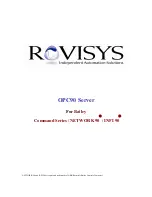
Chapter 6: BIOS
79
Link L0p Enable
Select Enable to enable Link L0p. The options are Disable, Enable, and
Auto
.
Link L1 Enable
Select Enable to enable Link L1 (Level 1 link). The options are Disable, Enable, and
Auto
.
IO Directory Cache
Select Enable for the IODC (I/O Directory Cache) to generate snoops instead of generating
memory lockups for remote IIO (InvIToM) and/or WCiLF (Cores). Select Auto for the IODC to
generate snoops (instead of memory lockups) for WCiLF (Cores). The options are Disable,
Auto
, Enable for Remote InvItoM Hybrid Push, InvItoM AllocFlow, Enable for Remote
InvItoM Hybrid AllocNonAlloc, and Enable for Remote InvItoM and Remote WViLF.
Isoc Mode
Select Enable to enable Isochronous support to meet QoS (Quality of Service) requirements.
This feature is especially important for Virtualization Technology. The options are Disable,
Enable, and
Auto
.
Memory Configuration
Enforce POR
Select POR to enforce POR restrictions for DDR4 memory frequency and voltage
programming. The options are
POR
and Disable.
Memory Frequency
Use this feature to set the maximum memory frequency for onboard memory modules. The
options are
Auto
,
1866, 2000, 2133, 2200, 2400, 2600, and 2666.
Data Scrambling for NVDIMM
Select Enable to enable data scrambling for onboard NVDIMM memory to enhance system
performance and security. The options are
Auto
, Disable, and Enable.
Data Scrambling for DDR4
Select Enable to enable data scrambling for DDR4 memory to enhance system performance
and security. The options are
Auto
, Disable, and Enable.
tCCD_L Relaxation
If this feature is set to Enable, SPD (Serial Presence Detect) will override tCCD_L ("Column
to Column Delay-Long", or “Command to Command Delay-Long” on the column side.) If
this feature is set to Disable, tCCD_L will be enforced based on the memory frequency.
The options are Enable and
Disable
.
Enable ADR
Select Enable for ADR (Automatic Diagnostic Repository) support to enhance memory
performance. The options are Enable and
Disable
.















































